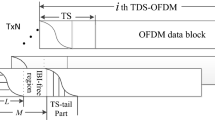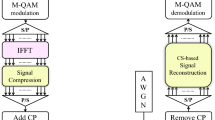Abstract
Owing to its success in 4G, Orthogonal Frequency Division Multiplexing (OFDM) made its contenting presence in 5G communications. To accommodate massive 5G data, it would be quite opportune to maintain significant reduction in overhead, while also ensuring reliable symbol detection at the receiver. For instance, reducing pilot symbol transmissions required for OFDM channel estimation, still retaining the efficacy of symbol detection is propitious. In this regard, contemporary compressive sensing framework with sparse recovery approaches such as Orthogonal Matching Pursuit (OMP) and Sparse Bayesian Learning (SBL) have been widely investigated in the literature. However study on approaches such as Least Absolute Shrinkage and Selection Operator (LASSO), Split Augmented Lagrangian Shrinkage Algorithm (SALSA) and corresponding investigations with experimentally acquired data frames are very less explored. In this work, by modifying the group LASSO optimization, a sparse recovery approach is proposed for OFDM channel estimation, particularly for a severely less pilot scenario. A non-coherent OFDM wireless link is developed using two Universal Software Radio Peripheral (USRP) devices, and several complex baseband OFDM frames are extracted in an indoor wireless lab environment for different receiver gains. Sparse recovery approaches are incorporated in two scenarios, namely number of pilots less than and severely less than channel length. The results of Mean Square Error (MSE) and Bit Error Rate (BER) versus receiver gain, show that the proposed approach outperforms all the other considered approaches. Particularly, while estimating CIR of length 20 with the proposed approach, employing 17 pilots resulted in BER of 0.0050, which degraded to only 0.0099 in a 5 pilot scenario, thus accommodating severe reduction in pilot overhead.










Similar content being viewed by others
References
Khanh Q V, Hoai N V, Manh L D and Le A N, Jeon G 2022 Wireless communication technologies for IoT in 5G: Vision, applications, and challenges. Wirel. Commun. Mob. Comput. 1–12
Daddanala R, Mannava V, Tawlbeh L A and Al-Ramahi M 2021 Vehicle to Vehicle (V2V) Communication Protocol: Components, Benefits, Challenges, Safety and Machine Learning Applications. arXiv preprint arXiv:2102.07306 86–98
Lokhande M P and Dipti D P 2021 Secured energy efficient machine-to-machine communication for telerobotic system. Inf. Med. Unlocked 26: 100731
Filipe C, Gomes M, Silva V, Dinis R, Silva A and Castanheira D 2020 A survey of candidate waveforms for beyond 5G systems. Electronics 10(1): 21
Sinem C, Ergen M, Puri A and Bahai A 2002 Channel estimation techniques based on pilot arrangement in OFDM systems. IEEE Trans. Broadcast. 48(3): 223–229
James G, Alvarez P and Wolisz A 2007 The signaling overhead in dynamic OFDMA systems: reduction by exploiting frequency correlation. In: 2007 IEEE International Conference on Communications, pp. 5143–5148
Pallaviram S and Bhuma C M 2015 Weighted-noise threshold based channel estimation for OFDM systems. Sadhana 40: 2111–2128
Pallaviram S and Bhuma C M 2017 A survey on OFDM channel estimation techniques based on denoising strategies. Eng. Sci. Technol. Int. J. 20(2): 629–636
Marzetta Thomas L 2006 How much training is required for multiuser MIMO? In 2006 Fortieth Asilomar Conference on Signals, Systems and Computers 359–363
Meenu R, Dhok S B and Deshmukh R B 2018 A systematic review of compressive sensing: Concepts, implementations and applications. IEEE Access 6: 4875–4894
Berger Christian R, Wang Z, Huang J and Zhou S 2010 Application of compressive sensing to sparse channel estimation. IEEE Commun. Mag. 48(11): 164–174
Nina W, Gui G, Zhang Z, Tang T and Jiang J 2011 A novel sparse channel estimation method for multipath MIMO-OFDM systems. In: 2011 IEEE Vehicular Technology Conference (VTC Fall), pp. 1–5
Renu J, Ambat S K and Hari K V S 2014 Low complexity joint estimation of synchronization impairments in sparse channel for MIMO-OFDM system. AEU Int. J. Electron. Commun. 68(2): 151–157
Ranjitha P and Murthy C R 2010 Bayesian learning for joint sparse OFDM channel estimation and data detection. In: 2010 IEEE Global Telecommunications Conference GLOBECOM, pp. 1–6
Tropp Joel A and Gilbert A C 2007 Signal recovery from random measurements via orthogonal matching pursuit. IEEE Trans. Inf. Theory 53(12): 4655–4666
Pooria P, Amini A and Marvasti F 2012 OFDM pilot allocation for sparse channel estimation. EURASIP J. Adv. Signal Process., pp. 1–9
Uwaechia A N and Mahyuddin N M 2018 Stage-determined matching pursuit for sparse channel estimation in OFDM systems. IEEE Syst. J. 13(3): 2240–2251
Tadayon A and Stojanovic M 2019 Iterative sparse channel estimation and spatial correlation learning for multichannel acoustic OFDM systems. IEEE J. Ocean. Eng. 44(4): 820–836
Renu J, Pavithran G and Aswathi C 2017 Sparse channel estimation in OFDM systems using compressed sensing techniques in a Bayesian framework. Comput. Electr. Eng. 61: 173–183
Tipping Michael E 2001 Sparse Bayesian learning and the relevance vector machine. J. Mach. Learn. Res. 1: 211–244
Wipf David P and Rao B D 2004 Sparse Bayesian learning for basis selection. IEEE Trans. Signal Process. 52(8): 2153–2164
Peter G, Mecklenbräuker C F, Xenaki A and Nannuru S 2016 Multisnapshot sparse Bayesian learning for DOA. IEEE Signal Process. Lett. 23(10): 1469–1473
Raghavendra P H, Saundharya Thejaswini R S, Venugopal K, Preethish Kumar M, Niveditha J and Pallaviram S 2021 Wideband spectrum sensing using sub-Nyquist sampling approaches. In: 2020 IEEE 3rd 5G World Forum (5GWF), pp. 69–74
Narendra B C, Pallaviram S and Mohan B C 2020 Sparse Bayesian learning assisted approaches for road network traffic state estimation. IEEE Trans. Intell. Transp. Syst. 22(3): 1733–1741
Xunyi Y, Lin P, He Z and Wu W 2007 Improving sequential Monte Carlo blind equalization in OFDM for sparse multipath channels. In: 2007 IEEE 8th Workshop on Signal Processing Advances in Wireless Communications, pp. 1–5
Srivastava Suraj Ch, Patro S K, Jagannatham A K and Hanzo L 2021 Sparse, group-sparse, and online Bayesian learning aided channel estimation for doubly-selective mmWave hybrid MIMO OFDM systems. IEEE Trans. Commun. 69(9): 5843–5858
Jonathan L, Chizhik D, Tulino A and Esnaola I 2016 Compressed sensing algorithms for OFDM channel estimation. arXiv preprint arXiv:1612.07761
Robert T 1996 Regression shrinkage and selection via the LASSO. J. R. Stat. Soc. Ser. B Stat. Methodol. 58(1): 267–288
Ivan S 2014 L1-norm penalized least squares with SALSA. Connexions 1–18
Afonso Manya V, Bioucas Dias J M and Figueiredo M A T 2010 Fast image recovery using variable splitting and constrained optimization. IEEE Trans. Image Process. 19(9): 2345–2356
Anitha K, Jaison B and Nalini M 2020 A novel enriched LASSO based compression technique for energy efficient wireless sensor networks. Adv. Syst. Sci. Appl. 20(1): 66–82
Slavche P and Kafedziski V 2014 Asymptotic capacity lower bound for an OFDM system with LASSO compressed sensing channel estimation for Bernoulli-Gaussian channel. IEEE Commun. Lett. 19(3): 379–382
Ghanbar A and Sharifi A A 2022 Performance improvement of OFDM systems using compressive sensing with group LASSO signal reconstruction algorithm. Wirel. Netw. 28(8): 3771–3778
Chihiro T, Mimura K and Iwata K 2021 Typical performance of iterative reweighted LASSO for compressed sensing. In: 2021 29th European Signal Processing Conference (EUSIPCO), pp. 1940–1944
Frank D, Mukherjee S and Initiative A D N 2020 The joint LASSO: high-dimensional regression for group structured data. Biostatistics 21(2): 219–235
Robert T, Saunders M, Rosset S, Zhu J and Knight K 2005 Sparsity and smoothness via the fused LASSO. J. R. Stat. Soc. Ser. B Stat. Methodol. 67(1): 91–108
Ming Y and Lin Y 2006 Model selection and estimation in regression with grouped variables. J. R. Stat. Soc. Ser. B Stat. Methodol. 68(1): 49–67
Yedukondalu K and Pollamoni S 2021 Implementation of OFDM system with companding for PAPR reduction using NI-USRP and LabVIEW. In: 2019 IEEE International WIE Conference on Electrical and Computer Engineering (WIECON-ECE), pp. 1–4
Nandesh O N, Rikitha S, Saniha A, Aditi P and Pallaviram S 2022 A USRP based UHF wireless sensor node and fusion centre for aquaponics system monitoring. In: 2022 3rd International Conference for Emerging Technology (INCET), pp. 1–7
Toan ND 2013 Implementation of OFDM systems using GNU Radio and USRP
Özgür O, Anjinappa C K, Hamila R, Al-Dhahir N and Güvenç I 2019 Joint frame synchronization and channel estimation: Sparse recovery approach and USRP implementation. IEEE Access 7: 39041–39053
Nandana N and Pallaviram S 2023 Performance of a software defined radio based non-coherent OFDM wireless link. Int. J. Electron. Telecommun. 537–544
Bassant S, Muhaidat S, Sofotasios P C, Sharif B S, Stouraitis T, Karagiannidis G K and Aldhahir N 2020 Performance analysis of coherent and noncoherent modulation under I/Q imbalance effects. IEEE Access 9: 36125–36139
Yeonsu K, Kim K and Park H 2007 Efficient DFT-based channel estimation for OFDM systems on multipath channels. IET Commun. 1(2): 197–202
Heath Robert W 2012 Digital Wireless Communication: Physical Layer Exploration Lab using the NI USRP: Student Lab Manual. National Technology and Science
Moose Paul H 1994 A technique for orthogonal frequency division multiplexing frequency offset correction. IEEE Trans. Commun. 42(10): 2908–2914
Stephen B, Parikh N, Chu E, Peleato B and Eckstein J 2011 Distributed optimization and statistical learning via the alternating direction method of multipliers. Found. Trends Mach. Learn. 3(1): 1–122
Ljubiša S, Sejdić E, Stanković S, Dakovi M and Orović I 2019 A tutorial on sparse signal reconstruction and its applications in signal processing. Circuits Syst. Signal Process. 39: 1206–1263
Amir B 2017 First-order methods in optimization. Society for Industrial and Applied Mathematics
Acknowledgements
We sincerely thank our university and our department, for allowing us to use the USRP NI2901 devices, the LabVIEW software and the laboratory facilities to carry out this research work. These devices are procured through a funded project GRD-732, sanctioned by VGST Karnataka under RGS-F 2017 scheme. Hence, we also thank the funding agency, VGST Karnataka, in this regard.
Author information
Authors and Affiliations
Corresponding author
Proposed solution of group LASSO
Proposed solution of group LASSO
Substituting \(F({\textbf {h}})\) from (20) and the chosen \(G({\textbf {h}})\) in (21), the modified Lagrangian \(J({\textbf {h}})\) becomes
,where the first term is split using \(\mathbf {\Phi }_{-k}\), \({\textbf {h}}_{-k}\) and \(\mathbf {\Phi }_{k}\), \({\textbf {h}}_k\) as
Vector differentiating (A2) for \({\textbf {h}}_k \ne {\textbf {0}}\) we get \(\frac{\partial J(\textbf{h})}{\partial \textbf{h}_k}\) as
Equating (A3) to zero, and simplifying it further, we get
Notating the right hand side of (A4) as \(\textbf{s}_k\), the solution is obtained as
However, (A5) has to be simplified to remove the dependency of \(\left\| {\textbf {h}}_k \right\| _2\) in it. Taking the norm of (A5), we get
where \(\lambda , d_k, \alpha _k\) are all positive constants and hence the inverse term, which is a scalar is written outside the norm operation. Simplifying (A6), we obtain
Substituting (A7) in the right hand side term of (A5) and simplifying it, the solution becomes
Note that (A8) is valid when \({\textbf {h}}_k \ne {\textbf {0}}\). If \({\textbf {h}}_k = {\textbf {0}}\), \( \left\| \textbf{h}_k \right\| _2\) becomes non-differentiable. In this case, the subdifferential of \( \left\| \textbf{h}_k \right\| _2\) is considered. Correspondingly, for the subgradient vector \({\textbf {v}}_k\) of \( \left\| \textbf{h}_k \right\| _2\) should satisfy
and further using the condition that \( \left\| {\textbf {v}}_k \right\| _2 \le 1\), when \({\textbf {h}}_k={\textbf {0}}\) [49]. Note that (A9) is similar to (A3) except that the sub differentiation of \( \left\| \textbf{h}_k \right\| _2\) is denoted as \({\textbf {v}}_k\), in place of differentiation of \(\left\| \textbf{h}_k \right\| _2\) in (A3). Simplifying (A9), we get \({\textbf {v}}_k=\frac{\alpha _k}{\lambda d_k}{} {\textbf {s}}_k\) and simplifying it with \( \left\| {\textbf {v}}_k \right\| _2 \le 1\), we get
Combining step (A8) to include the condition (A10), the closed from expression for the solution of group LASSO optimization in (20) is
where \(\left( a\right) _\mathbf {+}\) indicates soft thresholding operation.
Rights and permissions
Springer Nature or its licensor (e.g. a society or other partner) holds exclusive rights to this article under a publishing agreement with the author(s) or other rightsholder(s); author self-archiving of the accepted manuscript version of this article is solely governed by the terms of such publishing agreement and applicable law.
About this article
Cite this article
Narayana, N., Sure, P. & Bhuma, C.M. Experimental investigations on the applicability of LASSO based sparse recovery for compressively sensed OFDM channel estimation. Sādhanā 49, 133 (2024). https://doi.org/10.1007/s12046-024-02444-9
Received:
Revised:
Accepted:
Published:
DOI: https://doi.org/10.1007/s12046-024-02444-9




